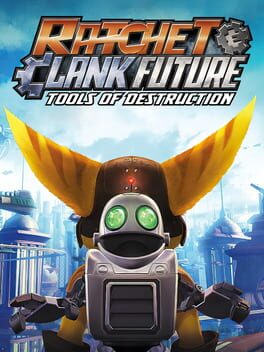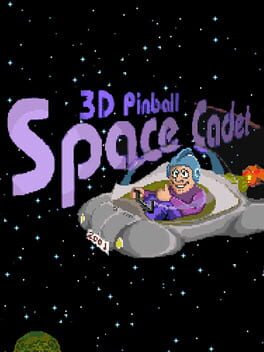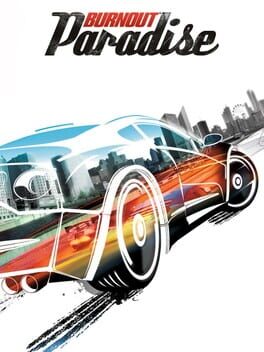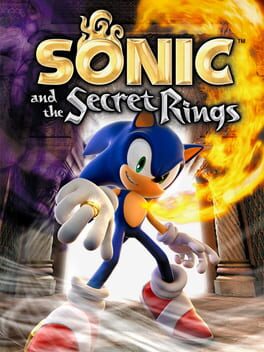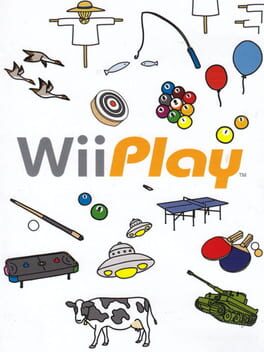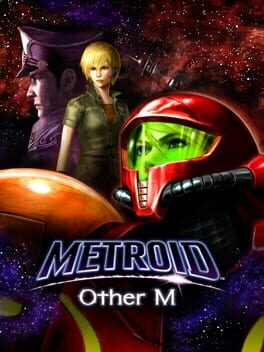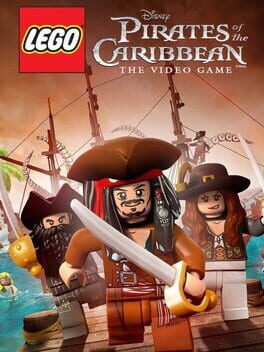shiftyrye27
31 reviews liked by shiftyrye27
Honestly, what a fine generational jump for Ratchet. This console generation is just about the perfect position for a game with the artstyle of R&C, old hardware not encouraging "realistic" texture vomit just for the sake of doing it, while at the same time improving enough over the past to allow for better lighting, filters, and surface effects. My disk is old and decrepit, often breaking the cutscenes, but whatever. I had a fabulous time with this game, loved so many of the weapons too. They straight up just give you a charge shot gun that fucking annihilates huge dinosaur guys.
This game does suffer from some repetitious enemy types that are a bit out of form for the franchise, but I do think the sheer amount of detail and fun in this limited cast does nearly make up for it. The main enemy types that Tachyon throws at you are these jaunty fishbowl robot men that crack and spill out their inhabitants when destroyed, how great. The story leaves some to be desired, but we are giving ratchet some lore. Whatever, not really why you pay admission for R&C.
This game has simpler gold bolts than the original trilogy, but many of these are located at the end of actually pretty carefully constructed, dare I say rewarding puzzles. Some of the gadgets are kind of a throwaway, but they're fun when implemented well (and they all have their moments). Tell me why this fucking game released 16 (SIXTEEN) years ago has better functioning and more enjoyable gyro puzzles than Breath of the Wild, a game I'm being told is the best ever and the blue ribbon standard of the open world genre. Did I ever feel less of a sense of discovery coming around a corner in R&C into a new environment than I did happening upon one of the scant few surprise structure encounters in BotW? No, not really, because I'm not a moron and I understand both to be structures engineered in this video game specifically to be found and explored by me, the player. I am not a baby or an idiot, so the fact of walking through a whole bunch of poorly textured, waving grass or not doesn't mystify me into thinking something drastically different is occurring. This R&C game has straight up more stuff to DO than so many games touted as life ruiners these days crammed into a package you can blast through in around a week if you're nasty. What is happening to this medium? Are games now intentionally wasting your time and hard drive space to keep you from entering the MTX ecosystems of other games? When I turned this fucking game on I didn't have to install anything. I didn't have to do a huge patch download that actually contains the game, with the disc itself acting as some kind of DRM ticket. Am I going on a completely insane tirade that has nothing to do with my enjoyment or evaluation of this game, freaking out about concepts foreign to it and the vast majority of games until GTA5 dropped about half a decade later? Yes.
Can we like... go back to this?? I drastically prefer the carefully curated content of a game like this to the all-consuming open-world archetype's compression of all things into Traveling Around And The Map Is Big. I feel like this sort of game dying and the Open World Form becoming so commonplace is sort of indicative of a general death of the craft. It takes a lot of inspiration, creativity, and specific directorial skills to make More Good Content To Do in a theoretical case where you wanted to make a game like R&CF:ToD (lmfao) but huger! Way bigger! But the same sort of artistic flourish is not required for crafting a huge, cavernous, technologically impressive open world with realistic horse shitting and balls retracting mechanics. All that takes is the resources to put up a veritable army of 3D modelers, texture artists, etc... individual artists utilized by indecisive/incompetent "creatives" and studio execs for nothing more than building a resource library, of all things. A game with curated areas and content like this allows the designers to communicate ideas to you WITH the game design(!!!), not just with the writing and narrative. It makes me feel seen and as though I have entered dialog with another living, breathing human when I spot the little tricky, hidden access point to start a gold bolt platforming puzzle, not so much when I am given another waypoint to walk my fat ass over to.
Bless this fun little game (other than the electrified pirate guys that chase you down FUCK THEM) and bless video games! Also Mr. Zurkon is in this game and has specific taunts for different enemies. He wants smoke with everyone.
Oh, I also don't understand what the hell people are smoking when they say this game "loses the comedy" of the original trilogy. This game is plenty silly! Qwark is still a moron comic relief character, Ratchet and Clank have some fun and comic bants, there are silly characters, lines, interactions everywhere. Was the Plumber himself reappearing not enough of a gag for you? I think if this game does anything it's take a paring knife to the more cringeworthy or just flat out unfunny cuts from the first few games, leaving what is usually more refined and enjoyable comedy. Sure, it takes itself more seriously with the plot than the original trilogy... but that is mostly because it's actually bothering to have a plot! Seriously, have you played those games lately? They barely make any sense! Their "plots" are mostly an excuse for Ratchet to just go to different places, other than the actual attempt at something of a fleshed-out narrative in Arsenal (still halfhearted, only sort of has stakes that still have nothing really to do with the main characters at all). I mean, Going Commando is my favorite R&C game, but it has like 4 characters in it for god's sake.
ALSO they locked up my boy Slim Cognito. FREE HIM!
Edit: to contextualize the low enemy variety complaint, there are around 34ish truly unique enemy types in this game counting bosses, and an additional 6-8 slight remodel/recolor higher powered versions of previous stock enemies. This isn't awful, but the problem is more with pacing/variety than with the sheer number. You spend quite a few planets fighting room after room of drophyds and space pirates, while the larger variety of enemies are mostly consigned to a few less plot-integral planets and even exclusive to the gladiator arena. I wish more time had been devoted to increased variety among the recurring "faction" type enemies, but it's not that big of an issue.
This game does suffer from some repetitious enemy types that are a bit out of form for the franchise, but I do think the sheer amount of detail and fun in this limited cast does nearly make up for it. The main enemy types that Tachyon throws at you are these jaunty fishbowl robot men that crack and spill out their inhabitants when destroyed, how great. The story leaves some to be desired, but we are giving ratchet some lore. Whatever, not really why you pay admission for R&C.
This game has simpler gold bolts than the original trilogy, but many of these are located at the end of actually pretty carefully constructed, dare I say rewarding puzzles. Some of the gadgets are kind of a throwaway, but they're fun when implemented well (and they all have their moments). Tell me why this fucking game released 16 (SIXTEEN) years ago has better functioning and more enjoyable gyro puzzles than Breath of the Wild, a game I'm being told is the best ever and the blue ribbon standard of the open world genre. Did I ever feel less of a sense of discovery coming around a corner in R&C into a new environment than I did happening upon one of the scant few surprise structure encounters in BotW? No, not really, because I'm not a moron and I understand both to be structures engineered in this video game specifically to be found and explored by me, the player. I am not a baby or an idiot, so the fact of walking through a whole bunch of poorly textured, waving grass or not doesn't mystify me into thinking something drastically different is occurring. This R&C game has straight up more stuff to DO than so many games touted as life ruiners these days crammed into a package you can blast through in around a week if you're nasty. What is happening to this medium? Are games now intentionally wasting your time and hard drive space to keep you from entering the MTX ecosystems of other games? When I turned this fucking game on I didn't have to install anything. I didn't have to do a huge patch download that actually contains the game, with the disc itself acting as some kind of DRM ticket. Am I going on a completely insane tirade that has nothing to do with my enjoyment or evaluation of this game, freaking out about concepts foreign to it and the vast majority of games until GTA5 dropped about half a decade later? Yes.
Can we like... go back to this?? I drastically prefer the carefully curated content of a game like this to the all-consuming open-world archetype's compression of all things into Traveling Around And The Map Is Big. I feel like this sort of game dying and the Open World Form becoming so commonplace is sort of indicative of a general death of the craft. It takes a lot of inspiration, creativity, and specific directorial skills to make More Good Content To Do in a theoretical case where you wanted to make a game like R&CF:ToD (lmfao) but huger! Way bigger! But the same sort of artistic flourish is not required for crafting a huge, cavernous, technologically impressive open world with realistic horse shitting and balls retracting mechanics. All that takes is the resources to put up a veritable army of 3D modelers, texture artists, etc... individual artists utilized by indecisive/incompetent "creatives" and studio execs for nothing more than building a resource library, of all things. A game with curated areas and content like this allows the designers to communicate ideas to you WITH the game design(!!!), not just with the writing and narrative. It makes me feel seen and as though I have entered dialog with another living, breathing human when I spot the little tricky, hidden access point to start a gold bolt platforming puzzle, not so much when I am given another waypoint to walk my fat ass over to.
Bless this fun little game (other than the electrified pirate guys that chase you down FUCK THEM) and bless video games! Also Mr. Zurkon is in this game and has specific taunts for different enemies. He wants smoke with everyone.
Oh, I also don't understand what the hell people are smoking when they say this game "loses the comedy" of the original trilogy. This game is plenty silly! Qwark is still a moron comic relief character, Ratchet and Clank have some fun and comic bants, there are silly characters, lines, interactions everywhere. Was the Plumber himself reappearing not enough of a gag for you? I think if this game does anything it's take a paring knife to the more cringeworthy or just flat out unfunny cuts from the first few games, leaving what is usually more refined and enjoyable comedy. Sure, it takes itself more seriously with the plot than the original trilogy... but that is mostly because it's actually bothering to have a plot! Seriously, have you played those games lately? They barely make any sense! Their "plots" are mostly an excuse for Ratchet to just go to different places, other than the actual attempt at something of a fleshed-out narrative in Arsenal (still halfhearted, only sort of has stakes that still have nothing really to do with the main characters at all). I mean, Going Commando is my favorite R&C game, but it has like 4 characters in it for god's sake.
ALSO they locked up my boy Slim Cognito. FREE HIM!
Edit: to contextualize the low enemy variety complaint, there are around 34ish truly unique enemy types in this game counting bosses, and an additional 6-8 slight remodel/recolor higher powered versions of previous stock enemies. This isn't awful, but the problem is more with pacing/variety than with the sheer number. You spend quite a few planets fighting room after room of drophyds and space pirates, while the larger variety of enemies are mostly consigned to a few less plot-integral planets and even exclusive to the gladiator arena. I wish more time had been devoted to increased variety among the recurring "faction" type enemies, but it's not that big of an issue.
Burnout Paradise
2008
i was talking with people today about my profound lack of interest in the upcoming "Dark Souls is now OPEN WORLD" game Elden Ring and it led me to think about Burnout: Paradise. this game was made before it became a trend, an expectation, to move your previously linear, level-based series into the open-world and it shows, because in stark contrast to games like Halo: Infinite or Grand Theft Auto V, Paradise's open world is actually purposeful in a sense that suggests that the open world was part of a wider design goal, rather than an existing series trying to cram itself into an open-world format because that is The Done Thing.
because Paradise doesn't really play like other burnout games. sure, the core tenets of driving dangerously to build up boost to hit ludicrous speeds is still there, but the game is utterly transformed by how races are built. there aren't circuits in this game, not in the sense we traditionally think of it, anyway: instead, each race begins at a specific intersection and ends at one of eight end points, and you can take whatever route you want across the vast complex supercircuit that is Paradise City to reach it. burnout paradise is essentially an enormous tesseract of a racing game, one gigantic race that you are constantly learning and improving on, where each event has you creating your own paths and routes to victory, filling out an ever more complete understanding of Paradise City until you know it's streets better than you know your hometown's. paradise embraces openness in every part of it's design, and you'd think that wouldn't be notable in the open-world space, but it is.
in Red Dead Redemption 2, the open-world essentially ceases to exist the moment you talk to someone and enter one of the game's interminable missions. in Halo: Infinite and Far Cry, the vast map of the game essentially acts as a glorified level select for a set of activities, large and small, that comprise the existing gameplay loop of those franchises. the open-world is an illusion, a marketing point, a buzzword. it exists so someone on an E3 presentation can press a button and phwoar! wow! look how far we can zoom out on this map! but you're doing all the same things in the same ways as you did in all the other games, usually less interestingly because the designs of these linear systems and the concept of a vast, freely explorable worlds cannot collide and leave both intact.
to be an open-world game, Burnout Paradise had to change. it had to be fundamentally different from prior Burnouts to such an extent that there exist many fans of the earlier Burnout games who do not like Paradise at all, and vice versa. i happen to think paradise is great, but it is great in a way largely divorced from why Burnout 3: Takedown was great. and I think that's a good thing. it demonstrates that the team at criterion used the open-world to create a genuinely transformative experience. if Elden Ring or Sonic Frontiers or however many upcoming games in which your favorite franchises decide haphazardly graft themselves onto a Breath of the Wild map end up great, they will be great because they allow themselves to transform, and race out into a brand new world, rather than trying to inflict the old one onto it.
because Paradise doesn't really play like other burnout games. sure, the core tenets of driving dangerously to build up boost to hit ludicrous speeds is still there, but the game is utterly transformed by how races are built. there aren't circuits in this game, not in the sense we traditionally think of it, anyway: instead, each race begins at a specific intersection and ends at one of eight end points, and you can take whatever route you want across the vast complex supercircuit that is Paradise City to reach it. burnout paradise is essentially an enormous tesseract of a racing game, one gigantic race that you are constantly learning and improving on, where each event has you creating your own paths and routes to victory, filling out an ever more complete understanding of Paradise City until you know it's streets better than you know your hometown's. paradise embraces openness in every part of it's design, and you'd think that wouldn't be notable in the open-world space, but it is.
in Red Dead Redemption 2, the open-world essentially ceases to exist the moment you talk to someone and enter one of the game's interminable missions. in Halo: Infinite and Far Cry, the vast map of the game essentially acts as a glorified level select for a set of activities, large and small, that comprise the existing gameplay loop of those franchises. the open-world is an illusion, a marketing point, a buzzword. it exists so someone on an E3 presentation can press a button and phwoar! wow! look how far we can zoom out on this map! but you're doing all the same things in the same ways as you did in all the other games, usually less interestingly because the designs of these linear systems and the concept of a vast, freely explorable worlds cannot collide and leave both intact.
to be an open-world game, Burnout Paradise had to change. it had to be fundamentally different from prior Burnouts to such an extent that there exist many fans of the earlier Burnout games who do not like Paradise at all, and vice versa. i happen to think paradise is great, but it is great in a way largely divorced from why Burnout 3: Takedown was great. and I think that's a good thing. it demonstrates that the team at criterion used the open-world to create a genuinely transformative experience. if Elden Ring or Sonic Frontiers or however many upcoming games in which your favorite franchises decide haphazardly graft themselves onto a Breath of the Wild map end up great, they will be great because they allow themselves to transform, and race out into a brand new world, rather than trying to inflict the old one onto it.
Wii Play
2006
Spider-Man
2002
Spider-Man
2002
Metroid: Other M
2010
There seems to be a bit of revisionist history going on around Nintendo fanbase saying that Other M may have terrible story, its gameplay was solid.
It was not.
For a game to properly function, one of the most important thing is to have control scheme that actually works well. A game becomes an interactive medium through that control interface. That is the fundamental basis of all video games. Depending on what kind of a game it is and how fast-paced it is, one game can have be more lenient than others in terms of overall control design and responsiveness, but it is never right to have a bad control scheme. And bad control scheme always, always makes a game worse than it should be.
Metroid: Other M is a game with a god-awful control scheme. It simply does not work. A slower, more meditative game would be annoying to have a core gameplay mechanic where the way one holds the controller constantly changes; in a fast-paced action game, it is a sin. Almost every single boss battle forces the player to use missiles, which can only be shot when they are in first-person mode by holding the Wiimote up and pointing at the screen. Even then, it is a hassle to actually lock-on to the target, since for some bloody reason lock-on button and the "move screen around" button are both assigned to B, which honestly is two very conflicting things to begin with. Obviously, Samus cannot move when aiming in first-person, but for some reason, the enemies outside of her view are happy to attack her out of nowhere--something they didn't even allow in Metroid Prime, a game that's entirely in first-person and lets Samus move while aiming.
For reasons unknown, the game's only way of controlling is with Wiimote only--no nunchuck, no classic controller, just a single Wiimote. That means there are only two buttons for fast-paced action outside of the d-pad and the A button which is awkwardly placed to be readily used (it's used to change into Morph Ball). That means Other M, despite being a full 3D action-adventure game with multiple techniques, is controlled with less buttons than the GBA Metroid games. It is frankly absurd how terribly controlled this game is. Samus' movement is done through d-pad. In a 3D environment. There is no dedicated dodge button, the player can just tap the d-pad, and it has hilariously lenient window that they can spam it--until something offscreen randomly attacks Samus. Or even worse, they can attack when Samus is in concentration mode or aiming mode, at which point the player has to waggle the controller, which may or may not register despite the window for dodging is clearly designed with only button press in mind. It just does not feel good to play as an action game when its mechanics are chained by a controller that frankly does not have the capacity to be used for something like this. I don't say this because I hate motion-controls--I do like it when it's done well. I play Splatoon with motion controls. I love aiming with gyro on 3DS games. I play VR games. But Other M just has a poor, terribly thought-out motion control design, on top of fundamentally flawed scheme.
It's redundant to talk about how terrible Other M's story is, even outside of how they killed Samus' character and made some very problematic decisions in portraying her. But I want to talk about how the story is so bad that it actually makes gameplay worse. There are so many times where game places arbitrary restrictions on Samus by Adam not authorizing her to use certain weapons she already has. This becomes problematic in a level-design sense because it forces painfully needless backtracking in a game that is already bafflingly linear. Samus comes to an obstacle that is clearly possible to overcome with a weapon that has not yet been authorized, so only way is to go back, at which point Adam finally gives the green light to use the said weapon. The player is directed from one place to the next with no real exploation, not even in a contained sense like Fusion, at which point revisiting old places just become a chore. Fusion made linearity in story and level design into its strength; Other M is made linear for no reason at all.
Here is one specific example of how the game's awful narrative actually makes a bad boss battle even worse. Despite shoving down the whole "authorization" narrative gimmick into player's throat throughout the entire game, the game subverts the expectation by making the player to beat the penultimate boss of the main game (which also happens to be the most frustrating one) with a weapon that has been locked for the entire game until thus far--without telling them it has been unlocked. It is the only way to beat the boss, and not using it will literally kill Samus within seconds. Again, the game does not tell the player (as in, there is no authorization!) that that the said weapon is unlocked. The one time they actually need that confirmation, it's not there. There is no button prompt, no alarm message, no cutscene, nothing. The player just has to remember that they had it because it is one of the things they learn in the tutorial in the very beginning of the game, even though the game locks the player from using it right after, until the very last moment of that penultimate boss fight. The bad narrative device stabs the player in the back one last time.
There are games that are bad because the developers clearly did not have the talent or the passion. Then there are games that are bad because the ambition was too high and they simply did not have to resources to make it properly. Then there are these rare cases where they clearly have the resources, the passion and the talent with achievable ambitions, but they just make incomprensibly bad decisions over and over again. Metroid: Other M is that kind of a game. This is a game chock-full of baffling design decisions that somehow makes even less sense than its universally-hated narrative. That is saying something.
It was not.
For a game to properly function, one of the most important thing is to have control scheme that actually works well. A game becomes an interactive medium through that control interface. That is the fundamental basis of all video games. Depending on what kind of a game it is and how fast-paced it is, one game can have be more lenient than others in terms of overall control design and responsiveness, but it is never right to have a bad control scheme. And bad control scheme always, always makes a game worse than it should be.
Metroid: Other M is a game with a god-awful control scheme. It simply does not work. A slower, more meditative game would be annoying to have a core gameplay mechanic where the way one holds the controller constantly changes; in a fast-paced action game, it is a sin. Almost every single boss battle forces the player to use missiles, which can only be shot when they are in first-person mode by holding the Wiimote up and pointing at the screen. Even then, it is a hassle to actually lock-on to the target, since for some bloody reason lock-on button and the "move screen around" button are both assigned to B, which honestly is two very conflicting things to begin with. Obviously, Samus cannot move when aiming in first-person, but for some reason, the enemies outside of her view are happy to attack her out of nowhere--something they didn't even allow in Metroid Prime, a game that's entirely in first-person and lets Samus move while aiming.
For reasons unknown, the game's only way of controlling is with Wiimote only--no nunchuck, no classic controller, just a single Wiimote. That means there are only two buttons for fast-paced action outside of the d-pad and the A button which is awkwardly placed to be readily used (it's used to change into Morph Ball). That means Other M, despite being a full 3D action-adventure game with multiple techniques, is controlled with less buttons than the GBA Metroid games. It is frankly absurd how terribly controlled this game is. Samus' movement is done through d-pad. In a 3D environment. There is no dedicated dodge button, the player can just tap the d-pad, and it has hilariously lenient window that they can spam it--until something offscreen randomly attacks Samus. Or even worse, they can attack when Samus is in concentration mode or aiming mode, at which point the player has to waggle the controller, which may or may not register despite the window for dodging is clearly designed with only button press in mind. It just does not feel good to play as an action game when its mechanics are chained by a controller that frankly does not have the capacity to be used for something like this. I don't say this because I hate motion-controls--I do like it when it's done well. I play Splatoon with motion controls. I love aiming with gyro on 3DS games. I play VR games. But Other M just has a poor, terribly thought-out motion control design, on top of fundamentally flawed scheme.
It's redundant to talk about how terrible Other M's story is, even outside of how they killed Samus' character and made some very problematic decisions in portraying her. But I want to talk about how the story is so bad that it actually makes gameplay worse. There are so many times where game places arbitrary restrictions on Samus by Adam not authorizing her to use certain weapons she already has. This becomes problematic in a level-design sense because it forces painfully needless backtracking in a game that is already bafflingly linear. Samus comes to an obstacle that is clearly possible to overcome with a weapon that has not yet been authorized, so only way is to go back, at which point Adam finally gives the green light to use the said weapon. The player is directed from one place to the next with no real exploation, not even in a contained sense like Fusion, at which point revisiting old places just become a chore. Fusion made linearity in story and level design into its strength; Other M is made linear for no reason at all.
Here is one specific example of how the game's awful narrative actually makes a bad boss battle even worse. Despite shoving down the whole "authorization" narrative gimmick into player's throat throughout the entire game, the game subverts the expectation by making the player to beat the penultimate boss of the main game (which also happens to be the most frustrating one) with a weapon that has been locked for the entire game until thus far--without telling them it has been unlocked. It is the only way to beat the boss, and not using it will literally kill Samus within seconds. Again, the game does not tell the player (as in, there is no authorization!) that that the said weapon is unlocked. The one time they actually need that confirmation, it's not there. There is no button prompt, no alarm message, no cutscene, nothing. The player just has to remember that they had it because it is one of the things they learn in the tutorial in the very beginning of the game, even though the game locks the player from using it right after, until the very last moment of that penultimate boss fight. The bad narrative device stabs the player in the back one last time.
There are games that are bad because the developers clearly did not have the talent or the passion. Then there are games that are bad because the ambition was too high and they simply did not have to resources to make it properly. Then there are these rare cases where they clearly have the resources, the passion and the talent with achievable ambitions, but they just make incomprensibly bad decisions over and over again. Metroid: Other M is that kind of a game. This is a game chock-full of baffling design decisions that somehow makes even less sense than its universally-hated narrative. That is saying something.
